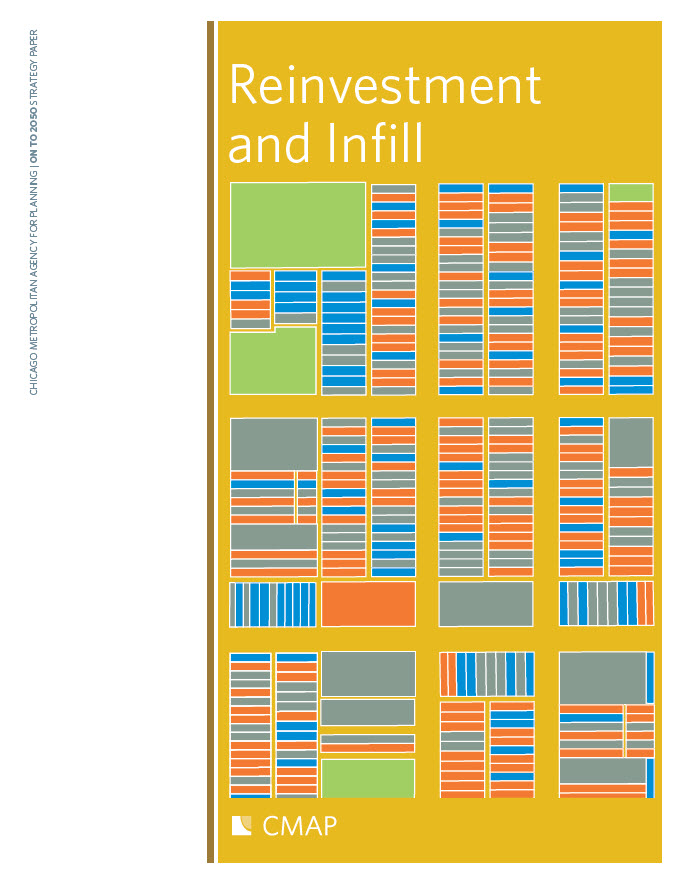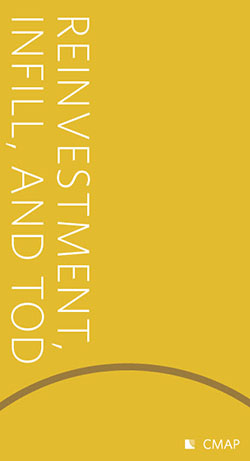Reinvestment and Infill Strategy Paper intro
Reinvestment and Infill
Update: The Reinvestment and Infill ON TO 2050 strategy paper is now available, and your feedback is welcome. Send your thoughts, ideas, or questions to ONTO2050@cmap.illinois.gov.
Reinvestment creates livable, sustainable communities.
Infill development, or growth that occurs in built-up areas with existing infrastructure, is a key strategy for reinvestment. This type of renewed investment helps revitalize economically disadvantaged communities, support new growth without building costly additional infrastructure, and preserve natural resources. Infill also makes communities more livable and sustainable by promoting walkability, housing and transportation choices, as well as access to schools, jobs, services, and basic amenities.
GO TO 2040 recognized the strong benefits of leveraging the region's existing assets and recommended that the region direct investment toward strengthening existing communities and find opportunities to encourage new development and redevelopment in livable communities that are denser and designed for mixed uses.

How ON TO 2050 can help promote further reinvestment and infill.
The region has many types of places that may be a priority for reinvestment and infill — transit station areas, suburban downtowns, main streets, employment centers, existing neighborhoods, disinvested areas, and many types of community activity centers. ON TO 2050 plan development will include a snapshot report that highlights infill and transit oriented development (TOD) trends in the region and a strategy paper that will explore types of areas, possibly to prioritize for investment.
ON TO 2050 will continue to emphasize the need to strengthen existing communities. And with input from public and private partners and other stakeholders, the plan's development will explore strategies for overcoming barriers to infill and reinvestment and for promoting livable communities.
Resource group members
As part of its ongoing and iterative research process, CMAP has formed resource groups in order to engage subject-area experts to help shape the plan's initial exploratory analysis. The purpose of the Reinvestment and Infill resource group is to provide input and insights as CMAP develops a strategy paper on Reinvestment and Infill. Our hope is that this resource group will provide a framework for both members of the group and CMAP staff to inform each other's work.
Resource groups are designed to meet for several months and disband when the strategy paper is completed, at which time the members will be invited to join standing CMAP committees or continue to participate in ongoing activities related to the next comprehensive plan in other ways.
|
Category |
Stakeholder |
Organization |
|
Private Development |
Larry Pusateri | Lightengale Group |
| Ben Ranney | Terra Firma | |
| Kevin D. Matzke | Clarious Partners | |
| Swasti Shah | Urban Land Institute | |
|
Economic Development |
James Wilson | Cook County |
| Hildy Kingma | Park Forest | |
| Scott Viger | Bensenville | |
|
Reinvestment and Underinvested Areas |
Yonah Freemark | Metropolitan Planning Council |
| Alan Quick | Illinois Housing Development Agency | |
| Jake Ament | LISC | |
| Rob Rose | Cook County Land Bank | |
| Kyle Smith | CNT | |
| Rich Wallach | IFF | |
|
Transportation |
David Kralik | Metra |
| Heather Tabbert | RTA |
This is your plan.
Continual input by stakeholder organizations and individuals was vital to the development and implementation of GO TO 2040. From now through the next plan's adoption in October 2018 and beyond, CMAP will be engaging a broad cross-section of partners from across the region.
Take a moment to fill out the questions below, and for more information on CMAP's public engagement efforts, please visit www.cmap.illinois.gov/get-involved.

